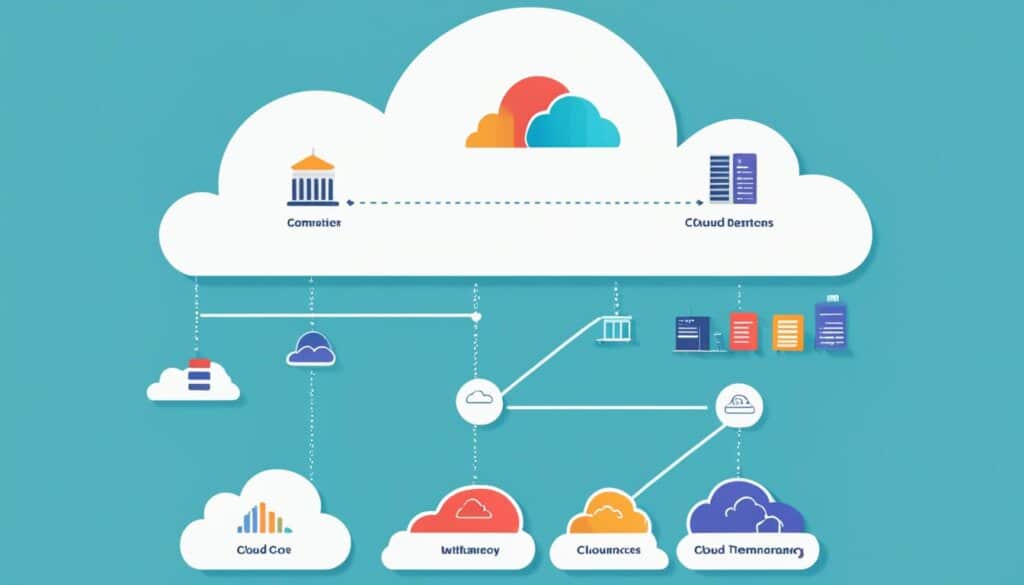Table of Contents
A multi-tenancy cloud is a cloud computing architecture that allows customers to share computing resources in a public or private cloud. Each tenant’s data is isolated and remains invisible to other tenants. In a multi-tenant cloud system, users have individualized space for storing their projects and data. The cloud network with multi-tenant architecture includes complex permissions to ensure that each user can only access their stored information and remains secure from other tenants.
Multi-tenancy can exist in both public and private clouds, with public cloud providers commonly using this model. Multi-tenant cloud networks provide increased storage and improved access compared to single-tenancy clouds. However, there are also drawbacks, such as increased security risks, lack of cost visibility, and potential performance issues due to the “noisy neighbour” effect.
In this article, we will delve into how multi-tenancy works, explore its benefits and drawbacks, and compare it to single-tenancy cloud architecture.
How Multi-Tenancy Works
In a multi-tenant cloud, customers or tenants can be individuals or groups within a single company, or entirely separate organizations in a public cloud. Each tenant’s data is isolated and inaccessible to all other tenants, ensuring data isolation and security. Access to the data is controlled through permissions granted by the cloud provider.
In a private cloud, the customers may be different individuals or groups within a single company, while a public cloud allows entirely different organizations to safely share server space. Multi-tenancy enables public cloud providers to run servers with single instances, making it more cost-effective and streamlining updates.
The virtualization of storage locations in cloud computing enables flexibility and easy access from different devices and locations, allowing tenants to work efficiently and collaboratively.
Below is a visual representation of multi-tenancy in a cloud infrastructure:
| Tenant | Data Isolation | Permissions |
|---|---|---|
| Tenant 1 | Yes | Read/Write |
| Tenant 2 | Yes | Read-Only |
| Tenant 3 | Yes | No Access |
The table above illustrates how multi-tenancy provides data isolation and different permission levels for each tenant within the cloud infrastructure. This ensures that tenants can securely store and access their data without compromising the privacy of other tenants.
Benefits and Drawbacks of Multi-Tenant Cloud
Multi-tenant cloud networks offer a range of benefits, including increased storage and improved access compared to single-tenancy clouds. By pooling computing resources, a multi-tenant cloud enables a larger group of people to access a greater pool of resources, without compromising on privacy, security, or application performance.
The virtualization of storage locations in cloud computing also provides flexible access from various devices and locations, allowing users to work seamlessly from anywhere. This flexibility enhances collaboration and productivity, as team members can easily access and share data, leading to more efficient workflows.
However, multi-tenant cloud networks are not without their drawbacks. The shared nature of resources poses a security risk, as tenants must rely on the robustness of the cloud provider’s security measures to protect their data from unauthorized access. Furthermore, the lack of cost visibility can make it challenging to determine the exact expenses associated with a multi-tenant network. Since databases are not separated per tenant, it becomes harder to allocate costs accurately.
Additionally, performance issues may arise due to the “noisy neighbor” effect. When multiple tenants share the same physical infrastructure, resource-hungry tenants can impact the performance of other tenants’ applications. This can lead to slower response times and reduced efficiency for those affected.
Benefits of Multi-Tenant Cloud
- Increased storage capacity
- Improved access to computing resources
- Flexible access from various devices and locations
- Enhanced collaboration and productivity
Drawbacks of Multi-Tenant Cloud
- Security risks due to shared resources
- Lack of cost visibility
- Potential performance issues caused by the “noisy neighbor” effect
Despite these drawbacks, multi-tenant cloud networks continue to be popular due to their cost-effectiveness and scalability. By leveraging shared resources, organizations can access advanced computing capabilities without incurring the full cost of dedicated infrastructure.

Multi-Tenancy vs Single-Tenancy Cloud
In a single-tenant cloud, only one customer is hosted on a server and is granted access to it. This allows for greater control over data management, storage, security, and performance. With exclusive server access, organizations can customize their environment according to their specific requirements, ensuring optimal data protection and resource allocation.
On the other hand, multi-tenant cloud architecture hosts multiple customers on the same servers, sharing computing resources. This necessitates a comprehensive understanding of the security and performance measures provided by the cloud provider. While multi-tenancy offers cost-effectiveness and efficiency, it may pose potential security risks and performance issues due to resource sharing among multiple tenants.
Although both architectures have their advantages and considerations, it is worth noting that multi-instance architectures differ from multi-tenant architectures. In multi-instance architectures, multiple instances of an application are shared, as opposed to a single instance in multi-tenancy. This allows for even greater flexibility and scalability in serving the needs of multiple organizations or users effectively.
FAQ
What is multi-tenancy in cloud computing?
Multi-tenancy in cloud computing is an architecture that allows customers to share computing resources in either a public or private cloud. Each tenant’s data is isolated and remains invisible to other tenants.
How does multi-tenancy work in the cloud?
In a multi-tenant cloud system, users have individualized space for storing their projects and data. The cloud network with multi-tenant architecture includes complex permissions to ensure that each user can only access their stored information and remain secure from other tenants.
What are the benefits and drawbacks of multi-tenant cloud networks?
Multi-tenant cloud networks provide increased storage and improved access compared to single-tenancy clouds. They make a greater pool of resources available to a larger group of people without sacrificing privacy, security, or slowing down applications. However, multi-tenant cloud networks also have some drawbacks, such as increased security risks, lack of cost visibility, and potential performance issues due to the “noisy neighbor” effect.
How does multi-tenancy differ from single-tenancy cloud?
In a single-tenant cloud, only one customer is hosted on a server and is granted access to it, allowing for more control over data management, storage, security, and performance. On the other hand, multi-tenant cloud architecture hosts multiple customers on the same servers, which requires a thorough understanding of the security and performance measures provided by the cloud provider.







